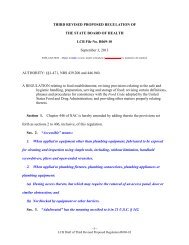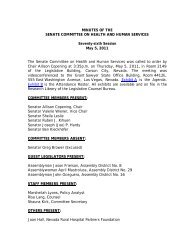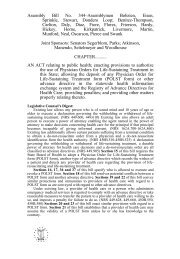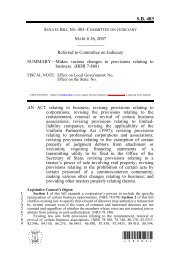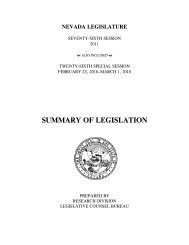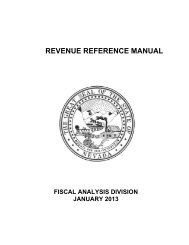Exhibit M-1
Exhibit M-1
Exhibit M-1
You also want an ePaper? Increase the reach of your titles
YUMPU automatically turns print PDFs into web optimized ePapers that Google loves.
5<br />
Option 3: Use traditional college admissions or placement tests<br />
www.ecs.org/per<br />
Setting a “college-ready” cut score on the English or math subsections of the ACT or SAT, or on national or state-developed college<br />
placement exams, is one approach states have taken to define college-readiness. Cut scores on college placement exams are almost<br />
universally used by two- and four-year postsecondary institutions to identify students in need of developmental education, but have<br />
been criticized by many observers as a tripwire unknown to the vast majority of college entrants, who are unaware that low scores<br />
on such exams could require them to complete (and pay for) remedial education before enrollment in credit-bearing coursework.<br />
Potential benefits of using ACT and SAT scores:<br />
Well-known. ACT and SAT are “known quantities” on which acceptable scores signal “college-readiness.” Defining college<br />
readiness by cut scores on well-known assessments that most four-year college applicants (and some two-year applicants)<br />
already take eliminates the “gotcha” factor that placement exams can create.<br />
More students taking ACT, SAT. States are increasingly requiring all students to take the ACT or SAT, thereby eliminating<br />
the possibility that less well-informed students (or students who intend to enroll in a community college) will choose not<br />
to take these exams. At least 12 states require all high school juniors to take the ACT or SAT, with additional states piloting<br />
district-level efforts or anticipated to adopt ACT/SAT-for-all.<br />
Opportunity to remediate early. Assessments administered well before college entry, such as SAT’s PSAT or ACT’s EXPLORE<br />
in 8th and 9th grade, and PLAN in 10th grade, can identify students at risk of not meeting college-readiness benchmarks<br />
while there’s still time to provide remediation before students sit for the ACT or SAT in 11th or 12th grade.<br />
Percentage of ACT test-taking population meeting college readiness benchmark scores, by subject:<br />
Academic years 1996–97 through 2009–10<br />
Percent<br />
100<br />
80<br />
40<br />
40<br />
20<br />
0<br />
English<br />
Reading<br />
Mathematics<br />
Science<br />
1996-97 1998-99 2000-01 2002-03 2004-05 2006-07 2008-09 2009-10<br />
Academic year<br />
Note: College readiness benchmark scores are based on the actual performance of approximately 90,000 college students from a nationally<br />
representative sample of 98 institutions and represent the level of achievement required for students to have a 50 percent chance of obtaining<br />
a B or higher or about a 75 percent chance of obtaining a C or higher in corresponding credit-bearing first-year college courses. These college<br />
courses include English Composition, College Algebra, an introductory social science course, and Biology. The Benchmarks are median course<br />
placement values for these institutions and as such represent a typical set of expectations. The benchmark scores, out of a total possible score of<br />
36, are 18 for English, 21 for Reading, 22 for Mathematics, and 24 for Science. Estimates are based on all students who took the ACT assessment<br />
during their sophomore, junior, or senior year and who graduated from high school in the spring of the respective year shown. Beginning<br />
in 2001–02, some states mandated participation in ACT testing for all high school seniors. Prior to that year, the test would have been taken<br />
primarily by those students who planned on attending college.<br />
Source: American College Testing Program, ACT National Scores Report, 1996–2010.<br />
Table Source: S. Aud, A. KewalRamani and L. Frohlich, America’s Youth: Transitions to Adulthood (NCES 2012-026). (U.S. Department of<br />
Education, National Center for Education Statistics. Washington, DC: U.S. Government Printing Office, 2011), page 45,<br />
http://nces.ed.gov/pubs2012/2012026.pdf (accessed March 8, 2012).



